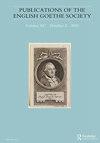纯粹的光:早期格林童话中的盲目、宗教和道德
IF 0.1
3区 文学
0 LITERATURE, GERMAN, DUTCH, SCANDINAVIAN
引用次数: 0
摘要
摘要:本文对选定的早期格林-金德和豪森(KHM)的失明进行了残疾研究。我主张将残疾的宗教模式作为阅读的方法论,并发展了一种新的模式,即道德模式:正如我所证明的,宗教模式将残疾定位于个人。相比之下,道德模式——通常与宗教模式混为一谈——应该是一种共生的方法论方法,将残疾定位在故事的道德结构中,而不是个人中。我的分析表明,在KHM中,失明等于诅咒。邪恶的角色由于罪恶和缺乏道德而受到惩罚,而善良的角色则免于这种惩罚。这种救赎通常是以奇迹般的治愈方式,通常是由上帝来实现的。本文章由计算机程序翻译,如有差异,请以英文原文为准。
Reines Licht: Blindness, Religion, and Morality in Selected Early Grimms’ Kinder- und Hausmärchen
ABSTRACT This paper undertakes a disability studies reading of blindness in selected early Grimms Kinder- und Hausmärchen (KHM). I argue for the use of the religious model of disability as a methodology for this reading and develop a new model known as the moral model: as I demonstrate, the religious model locates disability in the individual. In contrast, the moral model — which is often conflated with the religious model — should be a symbiotic methodological approach that locates the disability in the moral fabric of the tales rather than in the individual. My analysis shows that blindness equals damnation in the KHM. Evil characters are punished with it due to sin and a lack of morality, whereas good characters are saved from such a punishment. This salvation often takes the form of miraculous healing, often by God.
求助全文
通过发布文献求助,成功后即可免费获取论文全文。
去求助
来源期刊

Publications of the English Goethe Society
LITERATURE, GERMAN, DUTCH, SCANDINAVIAN-
CiteScore
0.10
自引率
0.00%
发文量
15
 求助内容:
求助内容: 应助结果提醒方式:
应助结果提醒方式:


